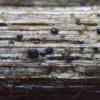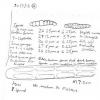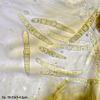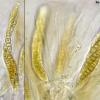
12-11-2025 09:25
 Viktorie Halasu
Viktorie Halasu
Hello, I need help with a pale terrestric Pseudom

11-11-2025 20:16
Bohan JiaHi, lastly I have found these tiny yellow decayin

09-11-2025 13:20
Hello.A tiny ascomycete, appearing as erupting gra

08-11-2025 00:29
 Francois Guay
Francois Guay
I found this species in Quebec, Canada, on herbace
Leptosphaeria / Phaeosphaeria on Juncus effusus
Peter Thompson,
01-08-2013 13:56
I recently found a species of Leptosphaeria or Phaeosphaeria growing on very decayed stems of Juncus effusus.
It seems that it represents a different species from those known to grow on Juncus, such as L. junci, L. juncicola and L. junciseda. Having considered many other species on grasses, sedges, reedmace and herbaceous plants, I still do not find a suitable species.
The main distinctive characteristic is 7-septate golden spores with the 4th cell distinctly swollen. The immature golden spores have 5 or 6 septa. Overmature spores are dark brown in colour and become mis-shapen. (Intermediate spores show that both the golden and dark brown spores are from the same species of Leptosphaeria.)
I have attached a photograph of the fruit bodies, which are quite old and have become partially erumpent. They have central ostioles and are more or less spherical.
I have also attached a rough microscopy sketch, with measurements and showing spores in two rows in the asci, though no complete asci were seen.
I wonder if anyone has an idea as to the species?
Thank you,
Peter.
Alain GARDIENNET,
01-08-2013 14:10
Re : Leptosphaeria / Phaeosphaeria on Juncus effusus
Hi Peter,
A Phaeosphaeria species. The closest one is P. sylvatica with 7-septate ascospores , 4-th cell enlarged, 18-28 x 4,5-5,5 µm and growing on grasses.
Probably, it's another species.
Alain
A Phaeosphaeria species. The closest one is P. sylvatica with 7-septate ascospores , 4-th cell enlarged, 18-28 x 4,5-5,5 µm and growing on grasses.
Probably, it's another species.
Alain
Björn Wergen,
01-08-2013 14:51

Re : Leptosphaeria / Phaeosphaeria on Juncus effusus
Hi Peter,
do the ascospores have a sheath or not? It will probably help by determination. Its definitely subgen. Spathispora and something like P. fuckeloides, P. silvatica etc.
regards,
björn
do the ascospores have a sheath or not? It will probably help by determination. Its definitely subgen. Spathispora and something like P. fuckeloides, P. silvatica etc.
regards,
björn
Alain GARDIENNET,
01-08-2013 14:59
Re : Leptosphaeria / Phaeosphaeria on Juncus effusus
Hi Björn,
P. fuckeloides have 6 septate ascpspores with the third enlarged. Here it's different apparently.
Alain
Björn Wergen,
01-08-2013 15:14

Re : Leptosphaeria / Phaeosphaeria on Juncus effusus
Hi Alain,
that is the confusing thing in Shoemaker&Babcock 1989, they draw the spores as being 6 septated, in the key it is keyed out under 7 septated and in the description is "6(8) septated".
I have a P. silvatica on my page, found on Brachypodium silvaticum, which seems to be a good host for this species. I have found 6- and 7 septated spores in this collection.
Hm I have attached the two species for a comparison. It is still not easy :P
regards,
björn
that is the confusing thing in Shoemaker&Babcock 1989, they draw the spores as being 6 septated, in the key it is keyed out under 7 septated and in the description is "6(8) septated".
I have a P. silvatica on my page, found on Brachypodium silvaticum, which seems to be a good host for this species. I have found 6- and 7 septated spores in this collection.
Hm I have attached the two species for a comparison. It is still not easy :P
regards,
björn
Peter Thompson,
01-08-2013 15:40
Re : Leptosphaeria / Phaeosphaeria on Juncus effusus
Hello Alain & Björn,
Thank you for your replies.
I see from the two images from Björn, that the spores in my sample resemble more closely the second image (of Phaeosphaeria silvatica), rather than P. fuckeloides. The cells in mine are almost the same length as each other, except for the swollen cell. In P. fuckeloides, the spores lack two septa and are 2um narrower than my measurements.
I did see 5- and 6-septate golden spores as well, which were probably not completely mature. Does the fact that I also saw as many dark brown, overmature and damaged spores in the same fruit body help as all?
It seems that there is a species 'sylvatica' as well as 'silvatica' in Species Fungorum. I assume that we are talking about P. silvatica?
Best Wishes,
Peter.
Thank you for your replies.
I see from the two images from Björn, that the spores in my sample resemble more closely the second image (of Phaeosphaeria silvatica), rather than P. fuckeloides. The cells in mine are almost the same length as each other, except for the swollen cell. In P. fuckeloides, the spores lack two septa and are 2um narrower than my measurements.
I did see 5- and 6-septate golden spores as well, which were probably not completely mature. Does the fact that I also saw as many dark brown, overmature and damaged spores in the same fruit body help as all?
It seems that there is a species 'sylvatica' as well as 'silvatica' in Species Fungorum. I assume that we are talking about P. silvatica?
Best Wishes,
Peter.
Peter Thompson,
01-08-2013 15:44
Re : Leptosphaeria / Phaeosphaeria on Juncus effusus
Hello Björn,
Sorry, I forgot to mention that I saw no sheaths surrounding the spores.
I will prepare another sample now to double check this, but I think that I should have noticed if there were any. If I find that there are sheaths, I will tell you.
Best Wishes,
Peter.
Sorry, I forgot to mention that I saw no sheaths surrounding the spores.
I will prepare another sample now to double check this, but I think that I should have noticed if there were any. If I find that there are sheaths, I will tell you.
Best Wishes,
Peter.
Björn Wergen,
01-08-2013 15:47

Re : Leptosphaeria / Phaeosphaeria on Juncus effusus
Hi Peter,
yes we do. I think silvatica is the correct spelling, from latin "silva" = forest.
regards,
björn
yes we do. I think silvatica is the correct spelling, from latin "silva" = forest.
regards,
björn
Alain GARDIENNET,
01-08-2013 15:58
Re : Leptosphaeria / Phaeosphaeria on Juncus effusus
silvatica=sylvatica, 2 orthographic variants.
The reason is explained in Shoemaker paper.
The reason is explained in Shoemaker paper.
Peter Thompson,
01-08-2013 16:29
Re : Leptosphaeria / Phaeosphaeria on Juncus effusus
Hello Alain & Björn,
I have had another look at the spores. There are no sheaths.
This time I am seeing spores which are mainly 5- and 6-septate, but most still 26 to 27.5um long. They are about 5.5um wide. When 6-septate, the 3rd rather than centre cell is swollen. Damaged dark brown spores still present as well.
As I had previously seen many 7-septate spores, I guess that those in the latest sample were not completely mature.
I will see if I can find the Shoemaker paper.
Best wishes,
Peter.
I have had another look at the spores. There are no sheaths.
This time I am seeing spores which are mainly 5- and 6-septate, but most still 26 to 27.5um long. They are about 5.5um wide. When 6-septate, the 3rd rather than centre cell is swollen. Damaged dark brown spores still present as well.
As I had previously seen many 7-septate spores, I guess that those in the latest sample were not completely mature.
I will see if I can find the Shoemaker paper.
Best wishes,
Peter.




